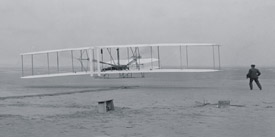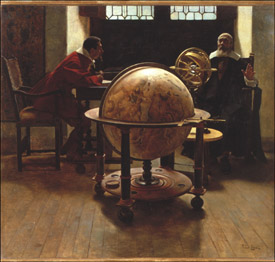Chapter 25
Challenging Our Beliefs
“Heaver-than-air flying machines are impossible.”
—Lord Kelvin, Cambridge scientist, president of The Royal Society, 1895

The first flight, 120 feet in 12 seconds, at Kitty Hawk, North Carolina, on December 17, 1903.
Source: Library of Congress
Only eight years later, two brothers who owned a bicycle shop, Orville and Wilbur Wright, proved Lord Kelvin wrong.

ca. 200 BCE-100 CE.
British Museum, London, Great Britain.
HIP/Art Resource, NY
Socrates was found guilty by a jury of five hundred fellow Athenians of refusing to recognize the gods (Zeus, Athena, Aphrodite, etc.) recognized by the state in 399 BCE. The jury sentenced him to death because he questioned the validity of what we now call mythology. [1]

Galileo instructing Vincenzo Viviani on the discourses
of the new science.
Portrait by Tito Lessi, 1892.
Museo della Scienza, Florence, Italy
In 1616, Galileo was found guilty of heresy by the Inquisition and forbidden to teach the Copernican theory that the Sun, not the Earth, is the center of the universe. The Inquisition proclaimed, “…the proposition of a stationary Sun is foolish and absurd…the doctrine attributed to Copernicus…cannot be defended or held.” [2] Galileo’s books were banned, and in 1633 he was condemned to life imprisonment for ignoring that ruling. Not until October 1992, during the papacy of Pope John Paul II, did the Catholic Church abandon that position.
From the 16th Century into the 19th Century, hundreds of thousands of people were accused of being witches. They were hideously tortured in order to extract a confession, without being found guilty. “Witches” were then hanged or burned alive. Many of those people were persecuted for their religious beliefs. However, all too often, they were just victims of paranoia and scapegoats for their accusers’ unrelated misfortunes.
“It ain't what you don't know that gets you into trouble.
It's what you know for sure that just ain't so.”
—Mark Twain
More recently, 40 to 50 thousand lobotomies were performed in America between 1936 and the late 1950’s. An ice pick-like instrument was inserted an inch or two into the brain through a hole drilled in the skull. The procedure was believed to be an effective treatment for severe mental illness and retardation. Many of those patients died from his procedure, and the rest suffered crippled emotions and personalities. They had to relearn how to eat and use the bathroom. They behaved childishly and they would sit motionless for hours. The most famous example was John F. Kennedy’s sister, Rosemary. Her childhood diaries described the people she met and the concerts and operas she attended. However, at 23, she underwent a prefrontal lobotomy. She lived out the rest of her life like a zombie in a nursing home, until her death at age 86. By the sixties, the lobotomy procedure was universally discredited.
[1]EyeWitness to History, “The Suicide of Socrates, 399 BC,” www.eyewitnesstohistory.com.
[2]J. J. O'Connor and E. F. Robertson, “Christianity and the Mathematical Sciences - the Heliocentric Hypothesis,” http://turnbull.mcs.st-and.ac.uk/history/HistTopics/The_rise_of_calculus.html.